
By Gabriela Baron
The La Niña has ended, the Philippine Atmospheric, Geophysical, and Astronomical Services Administration (PAGASA) said.
“Most of the climate models predict that [El Niño-Southern Oscillation (ENSO) (neither La Niña nor El Niño) is favored from March through June this year with an increased likelihood of a transition to El Niño (warm phase) thereafter,” PAGASA noted.
PAGASA, however, said that although La Niña has ended, its lag effect may still influence the probability of above-normal rainfall conditions coming in the months, including heavy rainfall, floods, flash floods, and rain-induced landslides in some highly vulnerable areas.
El Niño, meanwhile, increases the likelihood of below-normal rainfall conditions, which could have negative effects, such as dry spells and droughts, in some areas of the country.
“Amihan,” is also projected to weaken, while the easterlies will become predominant. -ag
